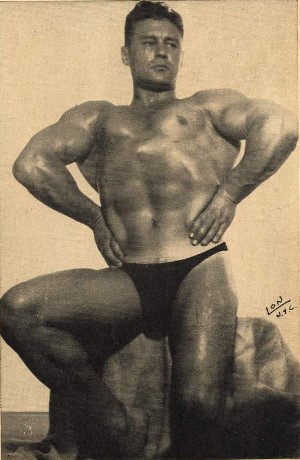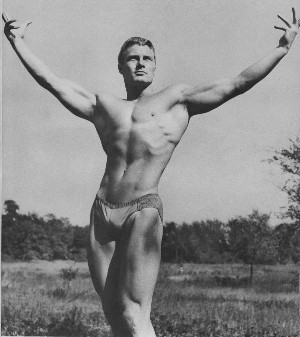YOUR GREAT BREATHING MUSCLE
by Joseph E. Weider
Editor-in-Chief and Publisher
Do you know the natural way to breathe? Where are your great breathing muscles located? How can they be strengthened and of what benefit can they mean to you? An enlightened article that should be read and practiced by everyone.

As you of course know, the diaphragm is the floor of the chest, separating the heart and lungs above from the stomach and liver below it; it is the partition between the thoracic and abdominal cavities.
We breathe in two ways: by raising the ribs and holding the diaphragm still, or secondly, by lowering the diaphragm while the ribs remain stationary. Of course, these methods may be combined, and most people really do blend them more or less.
When muscularly exerting ourselves we need all the air available, and we instinctively secure it by breathing deeply both ways. But, by far the greater portion of time is spent in comparative repose; so the manner of breathing during these hours must be highly important.
Diaphragmatic breathing — permitting the ribs to remain virtually stationary while we contract and relax the diaphragm — is the proper method for repose, and this is proved by several facts. The descent of the diaphragm gently massages all the organs below it, improving the digestive and eliminative functions. Habitual chest breathing leaves the abdominal organs inert, except when they are stirred by vigorous bodily exercise. Secondly, the absorption of oxygen from a given volume of air is greater when it is breathed diaphragmatically than when the chest method is used. Thirdly, breathing with “the floor of the chest” means a considerable economy of muscular energy, because to raise the ribs involves some of the body’s largest muscles.
But with the average person, the diaphragm grows weaker after the first few years of childhood. Unhealthful habits, tight clothing, and especially careless, stooping posture in walking and sitting, cramp the great breathing muscle. From inactivity, it finally loses nearly all of its involuntary action, moving only by an effort of our will. Many persons lose control of it entirely, and many suffer for years from various organic complaints as a result. One of the finest things any boy or girl could do for his or her health and strength is to guard against loss of the
diaphragm’s natural action, as he or she grows older.

Test yourself now. Stand erect, hands on front and sides of upper chest, fingers spread. Now take an ordinary breath and see where the expansion occurs. If you feel the ribs rise and your waistline remains unmoved, your breathing is chest respiration. If the ribs hold their place and the abdomen expands, you are breathing diaphragmatically — properly for all times except when exercising.
Sometimes a person, in trying to breathe diaphragmatically, will contract the abdominal muscles and mistake their expansion for the result of the diaphragm’s descent. Guard against that; the muscles must remain relaxed so that the diaphragm may descend easily. Its ascent is simply a matter of its own muscular relaxation between the downward movements. Practice persistently, always keeping your mind on the exercise. Every week’s work will show results, till the habit is formed.
I have known diaphragms to be so weak that no amount of effort while the person was standing would bring them under voluntary control. In such cases one must lie down. Reclining on the back makes diaphragmatic breathing far easier, and by keeping the hands on the chest walls one can tell very accurately how he is coming on.
Breathe slowly, letting inhalation and exhalation occupy about the same length of time. Never hold your breath for more than a few seconds. At first you should not try to breathe very deeply; for your diaphragmatic capacity may be small for several weeks, and a too forceful inspiration will shift you into the chest method.


